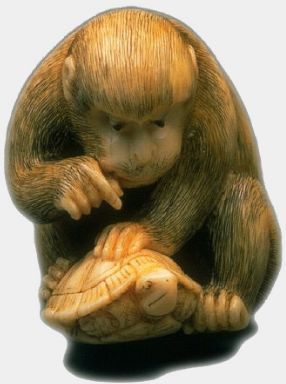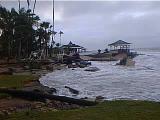16.2.03 0600 to 0910
We enjoyed the charter flight by Aerolineas Argentinas from Buenos Aires to Ushuaia with some 140 other passengers and staff on the Cruise. The new terminal in Ushuaia with a finger dock and other modern facilities as well as brand new parking and access roads reminded us of the financial difficulties of Argentina, and the horrendous external debt they must service. But at least, in this particular case, those investments went in the right direction as tourism at present is the only stable foreign exchange income that is growing at all.
1600 boarding the MS BREMEN which arrived form Antarctica this very morning. Ours will be the 6th and last cruise of the 2002/2003 summer season; after arriving in Buenos Aires, the BREMEN will steam north to Brazil and then a further several thousand kilometers up the Amazon river to Iquitos.
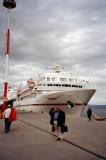 |
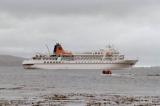 |
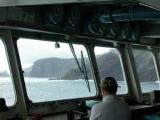 |
| MS BREMEN in the Port of Ushuaia, the southernmost city of the world, 16.2.03 |
MS BREMEN off the coast at Cape Hoorn, 17.2.03 |
On the bridge near Cape Hoorn, with cruise director Gabriele Engler. |
We are led by a charming Filipino hostess Delia to our cabin 702 on the top deck on the port side of the 111 m long white ship. A bottle of champagne is waiting, and a plate of delicious appetizers is brought soon after we arrive. Of course, our 2 large suitcases are already on board, having been left at the Caesar Park for pick up at 10 pm on the 15th.
This ship, which will be home away from home for the coming 2 weeks, is not a true cruise ship though she is quite comfortable. Her size is much smaller than what we normally see, with some 82 cabins (all outside) for a total of 164 passengers. On this cruise, we are about 120 passengers, the oldest being our neighbor, whose 93rd birthday comes next month. The BREMEN is an explorer type vessel and has the highest ice class rating; she is carrying a dozen Zodiacs to take passengers on the many shore landings, always wet landings in the Antarctic region. You immediately notice that she must have been built in Japan (actually in Kobe) because the locks open in the wrong way for Europeans or Americans.
Of course, there is a sauna, a small sea water swimming pool with a constant temperature of 27 degrees C, a fitness room, a hair salon, a boutique, a small hospital and a helicopter landing pad on deck 8 just above us.
The crew is mainly Filipino (bosun, sailors, hostesses-maids, kitchen personnel, handymen-helper at landing, and machinists), the majority of the officers are German with one exception: the executive officer is a Swiss lady from Pfaeffikon on Lake Zurich. The lecturers are from Eastern Europe and Germany; we have a German geologist living in Buenos Aires, 2 biologists, and one scientist specializing in glaciology, etc.
The executive chef is ‘Skinny’ Willy (Leitgeb) from a Tyrolean valley. ‘Fat’ Willy (Bosshard) met him the first day and wondered loudly what the food was going to be like with a chef so skinny, adding at the same time that of course if he was a lucky bugger who could eat anything without fear of putting on weight, then that was a fine recommendation for his skill.
The skipper is a 34 year old German from Hamburg; we were guests at his table on the day of the Captain’s Welcome. It would seem that captains are no longer in their sixties as I had pictured them from some motion pictures or soaps.
On 22.2.2001 , steaming in the South Atlantic towards Rio de Janeiro, the BREMEN was hit by a 30-35 m high ‘freak wave’ that smashed into the 2 cm thick Panzer glass. It did not actually break but was pushed into the Bridge by the many hundred tons of water. This led to a short circuit and a complete shutdown of all the navigation and control instruments on the bridge and also the heavy diesel engines. The alarm bells work from a battery that might be exhausted any time. To avoid this, the Chief Engineer Fisch ran up from deck 3 to deck 7 where the main fuse is located. The ship was on emergency electricity supplied by auxiliary power generator 1; it was not enough to also supply the power needed to start up the 6600 h.p. diesel engine. Fisch knows that only the reassembly of unit 2 (conveniently taken apart for a major overhaul) would give him sufficient power to start up the stopped main engine. He gives the orders and a 6 man crew starts to put the parts of the 150 kg block together in 70 degrees C heat, and coping with the rolling and heaving of the ship. The team is led by 3rd engineer Isabelo Turiano and mechanic Rolando Duyao. With their Filipino colleagues they make the impossible come true, and after 30 minutes, the auxiliary unit is fit again. The 2 diesels together supply enough power to get the air pressure to 13 BAR and increasing. The Chief Engineer starts the main diesel, and first the left side begins working, placing the BREMEN back into the wind. The successful mechanics have tears in their eyes, not only sweat. Mr. Turiano now works on the HANSEATIC, Mr. Duyao on a container ship. I just hope the passengers and the Management of Hapag Lloyd showed their gratitude to those involved in saving their lives and their BREMEN.
Monday 17.2.03
We weighed anchor at 0100 after having greeted the BREMEN’s larger sister ship the HANSEATIC mooring a short way apart. It was a slow trip down the Beagle channel towards Cape Horn, the southernmost point of South America. There we had our first Zodiac landing, with boots, water proof pants and an extra large parka that had taken a lot of time and negotiations to obtain. The weather was good, no winds and we had smooth sailing for a fine sleep.
To reach the top of the cliffs and the defunct lighthouse, there were many steep steps and they were quite slippery too. The little chapel was well kept and peaceful and in the small museum the Chilean occupants sold postcards and stamps.
Soon it was back to the BREMEN for the long trip south, some 40 hours for some 450 miles. Top speed is1 15 knots but she sails best at between 10 and 12 knots. We took course for Livingstone Island in the South Shetland Group.
Tuesday, 18.2.03
The full day spent at sea, steaming south. There were a number of interesting lectures by the accompanying specialists, on everything touching this region, be it geological, biological, the vegetation, glaciology, weather, exploration, you name it.
Wednesday, 19.2.03
We arrived at Livingstone Island around 0600. The first group left the BREMEN at 0730 in their Zodiacs, landing on a shallow beach of black sand. There, we saw the testimony of long bygone eras when the climate was mild and the Antarctic continent was not yet separated from Australia, say 70 million years back. You could see fossilized ferns and also petrified wood and even a pine cone. Next to these geological marvels were many Gentoo penguins, the young still with part of their plumage but clearly all in the process of molting (in German: mausern).
There were a couple of huge brown feathered southern giant petrels (Riesensturmvoegel) sitting at Hannah Point, they can have wing spans of up to 2 m and are comparable to the African vulture. However, contrary to their counterparts, they often kill other birds or even weak and sick penguins for food. We also saw 2 brown skuas attacking and killing a young penguin and then ripping it apart. After they had filled up, they left him there and soon a number of other penguins came investigating. It looked in a way as if they were paying their colleague their last respects. Skuas are also known to menace humans with their terrifying dive bombing attacks.
During lunchtime, we sailed toward Deception Island, which actually is the large caldera of a long extinct volcano. The entrance called Devil’s Bellows is about 250 m wide and leads into the crater lake of some 10×14 km, called Port Foster. Most passengers took to the Zodiacs to explore Telephone Bay (name of a sunken ship). Whilst we had a warm sun shining on us until the very entrance of Port Foster, fog set in as we passed through the entrance (named Cathedral Crags) and visibility became very poor so that the climb to the 300 m high rim of the crater did not bring about the wonderful view one normally can enjoy from there. All this took place in less than an hour and it shows how quickly weather conditions can and do change around here.
After the majority of the troop returned to ship, around 1500 the cruise director called for the 60 or so intrepid passengers to assemble, fully dressed but with swimming gear underneath, to board 6 Zodiacs to return to another spot to swim in the sometimes scalding water that comes from a geothermal source on the sea’s bottom, similar to the ones in New Zealand. These hardy people enjoyed themselves quite a bit and even swam into the ice cold waters (just around 2 degrees C, but after they returned to the BREMEN, I overheard a guy say that he had been freezing his balls off on the return trip by Zodiac.
The third landing of the day was late in the afternoon, to see the whaling station no longer in use. Built by the Norwegians at Whalers’ Bay in 1906, it was destroyed in 1927 by volcanic eruptions. It was rebuilt, but during the War, a British Commando dynamited the place to prevent the construction of a German Marine Base.
 |
 |
 |
| Cape Hoorn Memorial showing an albatross, with ‘red’ penguins |
2 Magellan Geese on a coastal peak at Cape Hoorn, the male is white, the female brownish |
Cape Hoorn Albatross Monument taken from a bit further away |
 |
 |
 |
| Lecturers at Hanna Point checking conditions, with some whale bones, 19.2.03 |
Fossilized ferns, wood, even a pine cone were found at Hanna Point which proves that in earlier periods of the earth’s formation, the Antarctic was warm and even tropical |
A huge whale vertebra, indicating that the mammal must have measured some 30 m, probably a blue whale, on Neko Island, 21.2.03 |
 |
 |
 |
| Young penguins in the process of moulting on Hanna Point, 19.2.03. |
2 Young chinstrap penguin (Eselpinguin) |
Your’s truly after the first wet landing at Hanna Point |
 |
 |
 |
| Group of red penguins crossing over to another beach at Hanna Point |
Antarctic fur seal at the shore near Hanna Point |
On deck of Bremen, towards Deception Island, 19.2.03 |
 |
 |
 |
| Antarctic Fur Seal on Deception Island |
Digging a pool at Pendulum Cove, 19.2.03. There is hot water beneath the sand |
Various ‘red’ penguins taking a hot bath at Pendulum Cove |
 |
 |
 |
| Pensive Prof. Weber after the bath at Pendulum Cove |
Abandoned oil storage equipment from the whaling days at Whalers’ Bay, 19.2.03 |
On the way to the Crater Lake at Telephone Bay, 19.2.03 |
 |
| Crater Lake at Telephone Bay |
Fore more pictures, please go to Trips – Antarctic Exploration February 2003, Part II + III.

